Measuring the Metal Content of Crude and Residual Fuel Oils by EDXRF: A Rapid, Alternative Approach to ICP-OES
This study explores the possibility of measuring the metal content of crude oils using EDXRF in samples as received in both the direct and indirect excitation mode.
The accurate determination of the total metal content of crude oil can be a difficult technical challenge for most analytical techniques. Crude oil is a very complex mixture of hydrocarbons and many other types of contaminants, including dissolved gases, emulsified water droplets, and solid sludge material. To compound these difficulties, the required result is the total metals content of the complete sample being analyzed. As a result, removing the contamination before analysis adds a large amount of complexity to the analysis. Understanding the effects of these "contaminants" is critical to obtaining accurate data representing the entire sample. The "go-to" method has typically been an acid digestion, followed by a dry ashing, dissolution of the residue, and dilution in 5% HNO3 to finally present the sample for analysis by inductively coupled plasma–optical emission spectrometry (ICP-OES). The entire process is labor intensive and time consuming, with a typical sample taking 6–12 h to prepare for analysis. This study explores the possibility of measuring the metal content of crude oils using energy-dispersive X-ray fluorescence (EDXRF) in samples as received in both the direct and indirect excitation mode, which addresses these challenges but still maintains the integrity of the sample.
Crude oils cover a range of physical parameters depending on their hydrocarbon profile. This profile also determines the viscosity of the crude oil and is generally expressed in American Petroleum Institute (API) units (1). The lower the API value, the more viscous the crude oil, and generally contains a higher bitumen and asphaltene fraction. In addition, it is physically thicker, and needs to be heated to be handled for analysis purposes.
The higher the API value, the more fluid the oil, which is typically because of a higher percentage of volatiles and naphtha in the crude oils fractions. The volatility makes it difficult to handle because gas build up is inevitable, so most gathering companies will have some form of blending to address these two extremes and provide a product that is more suitable for handling.
Variables that determine the quality of a crude oil include the API value, which determines its workability; the sulfur content, which determines how much processing a crude oil requires to meet fuel standards; and the hydrocarbon profile, which determines the oil's economic suitability for a given refinery.
In addition, after the crude oil has been separated into its fractions in the distillation tower, the heavy bottoms fraction is introduced into the catalytic cracker for further breakdown and the end product is residual oil (a staple of marine fuels) (2).
Analysis Required to Characterize Crude Oil and Its Fractions
Table I shows the most common analysis metrics including metals content required to characterize the different types of crude oil distillates.
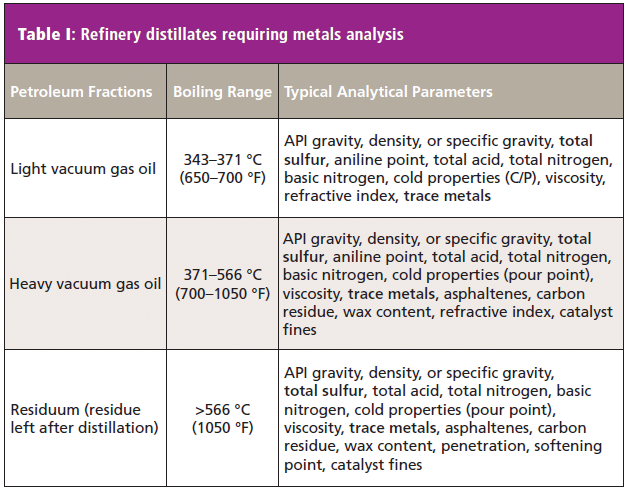
Analysis of Crude Oils for Sulfur and Metals Content
Loading and transporting crude oil is very often accompanied by foreign matter, such as sand and salt water. This disperses in the oil and forms emulsions and foams. Generally, crude oil is allowed to settle before sampling and subsequent analysis to allow these particulates to settle. In the event that sampling occurs at the well head or before gathering, these particulates may settle under the influence of gravity and pose a problem for the analysis of crude oil.
The degree of emulsion formation will be function of the oil's asphaltene and bitumen index, which translates to its API number, so heavier oils with lower API values are more problematic to analyze than their higher API, lower viscosity counterparts. The main challenge is obtaining a representative subsample for analysis.
In the desalter of most refineries the particulates are precipitated under the influence of the charged field and the particulates remaining depend on the mobility and particle size within the crude oil. Particle size distribution within crude oil can vary depending on the fineness of the silt or trapped particles, but generally a large portion of the particulates is removed at the gravity concentrator and desalter processes.
Buyers of crude oil are very clear that they need to understand the exact elemental make-up of the crude oil that they buy. Therefore, from an analytical perspective, all reasonable steps need to be taken to measure a representative sample to provide the required data.
Traditional Approaches for Crude Oil Analysis
Wavelength-dispersive X-ray fluorescence (WDXRF) and energy-dispersive X-ray fluorescence (EDXRF) have long been the methods for sulfur analysis and both the ASTM Methods D2622 (3) and D4294 (4) have been around for well over 20 years. They are fast, accurate, reliable, and, the EDXRF option in particular, is low cost.
The industry approach to strategic metal analysis has been to embrace inductively coupled plasma–optical emission spectrometry (ICP-OES) methodology, which calls for destruction of the crude oil matrix either by dry ashing with dissolution and dilution of the resulting ash in a perchloric–nitric acid solution (IP 501 and ASTM D5708 methods) (5,6) or direct dissolution in kerosene for direct measurement of the oil matrix, such as ASTM D5185 used for lubricating oils (7).
The ashing method is subject to loss of volatiles incurred during the open-ashing process. The challenge is to estimate the metal content ahead of time to ensure total dissolution of the ash content and to ensure accurate metal analyses by taking the correct initial sample mass. The direct dilution method is also subject to particulate precipitation and subsequent under estimation of concentration values. The hallmark of these methods is the length of time spent preparing the sample and how this would slow down the decisions made for blending and fueling of marine vessels at ports as well as rail cars held before authorizing transfer to holding tanks. Therefore, there is a real need for a quick, accurate alternative method that would identify and quantify the metals at the desired levels in a shorter time period to allow same day turnaround of results.
Pros and Cons of XRF
The optimum configuration for this type of analysis is a large X-ray spot size EDXRF system utilizing optimized excitation conditions on the surface of the sample to maximize the excited volume of sample and collect elemental intensities in the shortest possible time. The use of new, ultrafast, silicon drift detectors (SDDs) facilitates the intensity collection and contributes to the shorter analysis times needed. The high count rates and the ability to reach the desired precision in a relatively short amount of time with metal detection limits in the sub-parts-per-million range helps to mitigate the particulate precipitation challenge. The high intensity X-ray flux coupled with a close coupling geometry makes for highly precise analysis in a few hundred seconds.
The use of small spot size monochromatic capillary optics, while allowing a magnification of the X-ray flux for adequate performance, is still less efficient in terms of X-ray flux generation than a large spot polychromatic X-ray source using a similar target X-ray source. The result is that the monochromatic wavelength-dispersive X-ray fluorescence (MWDXRF) and monochromatic energy-dispersive X-ray fluorescence (MEDXRF) systems have to count for longer than the large spot size EDXRF system to achieve the same counting statistics. This longer count time allows for particulate deposition on the face of the X-ray cell or removal of the particulates with a side view cell from the X-ray path thereby leading to over and under estimation of the sulfur and metals content, which brings into question whether the analysis is actually representative of the sample as received.
If crude oils are left in the X-ray cup for a long time under the influence of the X-ray beam it has been shown that samples with a high sulfur and metal content will show an appreciable increase in the intensity signal because of the electrostatic precipitation of the sulfur and metals on the film under the influence of the X-ray beam. This increase is particularly true for high-powered WDXRF units. The effect is less marked for lower-powered EDXRF units.
Alternative XRF Approach
An alternative approach to mitigate the settling of particulates in the crude oil is to mix the crude oil with a solidification agent that freezes the particulates in situ and allows the resultant solid sample to be measured directly in the X-ray beam. This way an automated sample carousel can be used to allow for unattended operation during a 10-min analysis for Na, Al, Si, P, S, Cl, K, Ca, V, Cr, Fe, Ni, Zn, As, and Pb in crude oil and refinery products of residual fuel oil and vacuum gas oil using optimal acquisition settings for each element of interest.
For crude oils with a high volatile organic content, the sample film can bulge under the influence of the evolving gases, which can distort the sample interface relative to the analytical measuring plane. These types of samples are typically placed in cups with a vent hole in the caps that are opened to allow equilibration of the gases. However, analysis has to be completed in a relatively short amount of time for accurate assessment of the sulfur content. Prolonged analysis time-over 180 s-will lead to lower sulfur values because of the loss of hydrogen sulfide and mercaptans to the atmosphere. In addition, metals may become concentrated if the naphtha fraction out-gases and changes the oil volume. The solidification technique lowers the volatility of the sample and since its measured in an open cup, the volatiles can escape, but at a slower rate that will not affect the elemental concentration.
Experimental
A study was undertaken to compare the performance of this combination, direct excitation and secondary target (ST) EDXRF with the ICP-OES methods, for metals analysis on crude oils, fuel oils, and vacuum gas oils. The real-life samples were part of an ASTM round-robin run on the ICP-OES system using the IP 501 method, and the same samples were measured as received (no preparation) on the ST-EDXRF system to compare recoveries against pooled quantification data generated in the round-robin of 30 laboratories. Calibration of the ICP and ST-EDXRF systems was carried out using a 23-element standard diluted in 75 centistokes (cSt) mineral oil to simulate the sample viscosity of fuel oils and crude oils. Next, 5 g of sample was weighed into the XRF cups, using an ultrathin polyester film to provide the X-ray window.
In addition, recovery analysis of metal values based on analysis of the standard reference material (SRM) National Institute of Standards and Technology (NIST) 1085c (wear metals in lubricating oils) was also carried out. The lubricating oil standard was used to create three levels of concentrations for the metals: 3 ppm, 30 ppm, and 300 ppm. The direct and ST-EDXRF methods were compared to the IP 501 and D5185 methods for ICP-OES. The metal loading at 300 ppm proved too high for the ICP IP501 method, leaving residual undissolved ash particles in the acid digestion and solution, and therefore it was not measured.
Results
Recovery data for NIST 1085c SRM using the two methods are shown in Table II, while the comparison between both techniques for a 10x and 100x dilution of the SRM is shown graphically in Figure 1. Table III demonstrates correlation data between EDXRF and ICP-OES data for two fuel oils (FO 61605 and 61705) and crude oil (CO 1611) samples. All data are in units of milligrams per kilogram (mg/kg) except for sulfur which is in % (wt/wt) using an ASTM method for sulfur in petroleum products by EDXRF. Finally, Table IV represents repeatability data (standard deviation for 10 replicates) for fuel oil FO 61605 using the oil solidification method for ST-EDXRF described earlier.
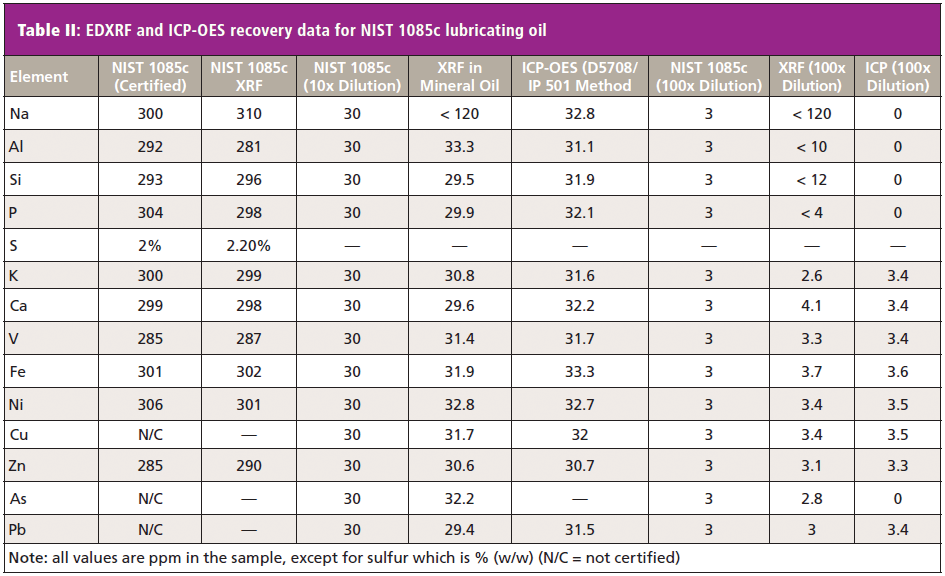
Summary
This study has shown that it is feasible to carry out fast screening for metal content in refinery inputs and process intermediates using minimal sample preparation for a number of elements in a relatively short time using the ST-EDXRF technique. It offers same day turnaround for economically critical fuels with the potential to quantify cat fines (Al + Si) to the ISO 8127:2015 guidelines (8) for marine fuels.

Figure 1: Correlation between ICP-OES and EDXRF for a 10x (blue and orange circles) and 100× dilution (yellow and gray circles) of NIST 1085c. (Note: Element numbers refer to the 14 elements referenced in Table II.)
Currently, the IP 501 method requires the analyst to have a prior knowledge of the metal content to estimate the ash weight correctly for dilution into the ICP calibration range. An EDXRF screening method would allow accurate estimation and thereby shorten the long ashing process. It may in fact be possible to use the ST-EDXRF data directly to report the metal content for several applications within the refinery and for refinery products such as fuel oil. However, the biggest incentive for using the ST-EDXRF method is the time savings on sample preparation and the more immediate impact of data to facilitate commercial transactions.
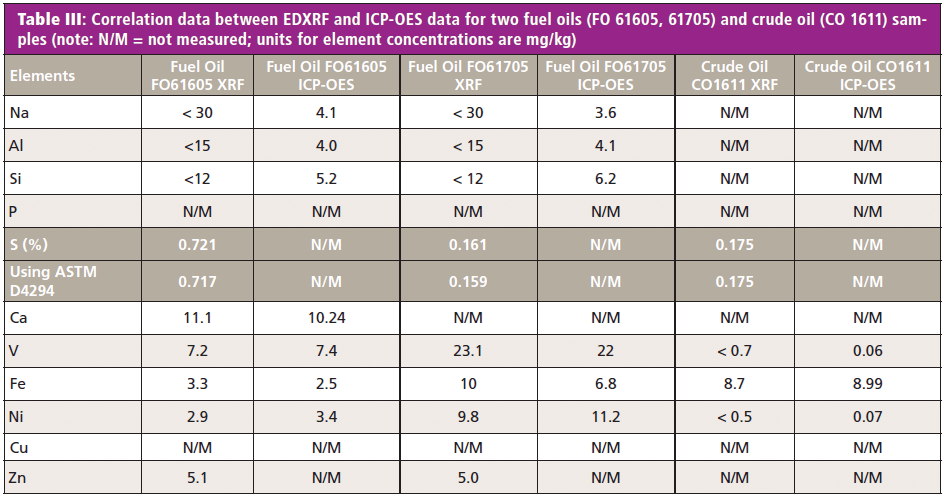
Acknowledgments
The author would like to thank Johnny Loy of Intertek, Signal Hill in California for the comparative ICP-OES analysis and for providing the ASTM Proficiency Standards for correlation of ICP-OES and ST-EDXRF. All tests were carried out on the Genius IF ST-EDXRF system (Xenemetrix Ltd.).
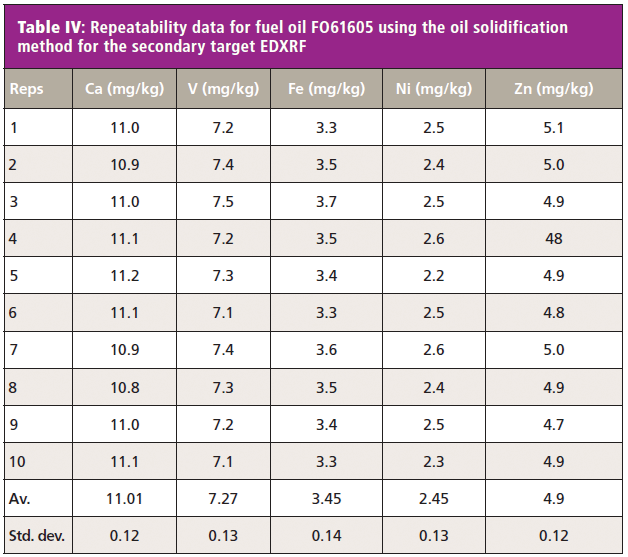
Robert Thomas is the editor of "Atomic Perspectives" and reviewed this article submission.
References
(1) "What Is API Gravity," Petro Industry News, https://www.petro-online.com/news/fuel-for-thought/13/breaking-news/what-is-api-gravity/33309.
(2) "Everything You Need to Know About Marine Fuels - Chevron Marine," www.chevronmarineproducts.com/...marine/.../Chevron_EverythingYouNeedToKnow.
(3) ASTM D2622 – 16, "Standard Test Method for Sulfur in Petroleum Products by Wavelength Dispersive X-ray Fluorescence Spectrometry," https://www.astm.org/Standards/D2622.htm.
(4) ASTM D4294, "Standard Test Method for Sulfur in Petroleum Products by Energy Dispersive X-ray Fluorescence Spectrometry," https://www.astm.org/Standards/D4294.htm.
(5) “Determination of Aluminum, Silicon, Vanadium, Nickel, Iron, Sodium, Calcium, Zinc and Phosphorus in Residual Fuel Oil by Ashing, Fusion and Inductively Coupled Plasma Emission Spectrometry,” https://publishing.energyinst.org/ip-test-methods/full-list-of-ip-test-methods-publications/ip-501-determination-of-aluminium,-silicon,-vanadium,-nickel,-iron,-sodium,-calcium,-zinc-and-phosphorous-in-residual-fuel-oil-by-ashing,-fusion-and-inductively-coupled-plasma-emission-spectrometry.
(6) ASTM D5708 – 15, "Standard Test Methods for Determination of Nickel, Vanadium, and Iron in Crude Oils and Residual Fuels by Inductively Coupled Plasma (ICP) Atomic Emission Spectrometry," https://www.astm.org/Standards/D5708.htm.
(7) ASTM D5185 – 18, "Standard Test Method for Multielement Determination of Used and Unused Lubricating Oils and Base Oils by Inductively Coupled Plasma Atomic Emission Spectrometry (ICP-AES)," https://www.astm.org/Standards/D5185.htm.
(8) ISO 8217:2017, "Petroleum products - Fuels (class F) – Specifications," https://www.iso.org/standard/64247.html.
Laura Oelofse

Laura Oelofse runs her own consulting company, XRF Sales and Consulting, based in Manor, Texas. She has a master's degree in technology from the University of Johannesburg and has had many active years in the XRF business, both as a user for large mining companies and as an academic researcher. More recently she has worked as an EDXRF/WDXRF scientist for a number of well-respected XRF vendors. She has more than 35 years of XRF experience, many of them in the petroleum and petrochemical sectors.
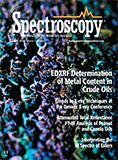
Applications of Micro X-Ray Fluorescence Spectroscopy in Food and Agricultural Products
January 25th 2025In recent years, advances in X-ray optics and detectors have enabled the commercialization of laboratory μXRF spectrometers with spot sizes of ~3 to 30 μm that are suitable for routine imaging of element localization, which was previously only available with scanning electron microscopy (SEM-EDS). This new technique opens a variety of new μXRF applications in the food and agricultural sciences, which have the potential to provide researchers with valuable data that can enhance food safety, improve product consistency, and refine our understanding of the mechanisms of elemental uptake and homeostasis in agricultural crops. This month’s column takes a more detailed look at some of those application areas.